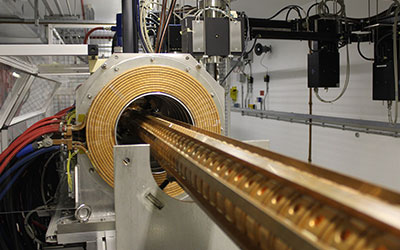
What is a Proton Beam?
A proton beam is a type of radiation that uses the hydrogen nucleus. A hydrogen atom consists of one proton and one electron. The proton is produced using hydrogen. An electron is removed from a hydrogen atom, accelerating to produce a proton beam.
Proton beams are classified as particle beams among radiation forms. There are several classifications in particle beams; in some cases, proton beams are classified as heavy particle beams. Carbon Ion Radiation Therapy (CIRT) is one of the most advanced therapies to improve cancer treatment in Japan. The carbon ion beams have been used for cancer therapy, and the proton beams are not classified as heavy particle beams.
What is a Heavy Ion Beam?
Heavy ion beam is a type of radiation classified as a particle beam. It includes all particle beams heavier than electrons. Carbon ion beams are commonly used for cancer therapy. The carbon ion beam is a flow of carbon nuclei that can be accelerated, and it is composed of six protons and six neutrons. Unlike carbon atoms, they are not accompanied by electrons.
The definition of heavy particle radiation in cancer treatment varies by country. In some cases, proton beams, heavier than electrons, may be included in heavy particle beams. In Japan's heavy ion therapy, however, "heavy particle beam" refers to beams produced from nuclei of atoms (heavy ions) with atomic numbers heavier than helium (He), with beams produced from carbon nuclei.

Features of Proton Beam and Heavy Particle Beam
Both proton and heavy particle beams are particle beams composed of atomic nuclei. The proton beam is an atomic nucleus of hydrogen, but the heavy particle beam is a carbon nuclei. Because of the difference in atomic weights, a proton beam has one proton, whereas a heavy particle beam has six protons and six neutrons. In other words, the particle weights are not the same.
In cancer therapy, both proton and heavy particle beams accelerate their respective nuclei to irradiate the target. Particle beams generate large amounts of energy when they enter and stop inside the body, destroying cancer cells with radiation without painful nor scary. The kinetic energy, as well as radiation deposition, depends on the mass of the nuclei.
The lightweight nuclei of proton beams have less energy than heavy particle beams. Compared to X-rays used in conventional radiotherapy, the proton beams have only about 1.2 times the energy of X-rays but can be irradiated to the body parts. They can also administer to a wider range of cancer cells than heavy ion beams because they affect the surrounding area less than heavy ion beams.
On the other hand, the heavy particle beams with heavy nuclei are highly charged. Therefore, they have the strong power to destroy cancer cells, and it is beneficial for treating osteosarcoma, bone, and soft tissue tumors, etc., which are technically difficult to remedy with conventional radiotherapy. In the meantime, heavy particle therapy could significantly affect healthy cells. Therefore, the administration will be limited depending on the affected parts.
The two radiotherapies have similar features. Both the proton and heavy particle beams require huge equipment to generate radiation. The electrons generated by the ion source are accelerated in a linear accelerator (linear accelerator) or synchrotron to irradiate the affected area. Using a rotating gantry, irradiation from any direction is available.
Other Therapeutic Radiations
The heavy ion beam is a type of radiation classified as a particle beam. Several types of particle beams are caused by electromagnetic radiations: Alpha, Beta rays, and neutron rays. Electromagnetic waves include Gamma rays and X-rays.
Alpha rays are helium nuclei, and beta rays are electrons, which are charged particles with a positive or negative charge. Proton and heavy particle beams (nuclei of hydrogen) are classified as charged particle beams. Neutron beams, on the other hand, have no charge and are uncharged particles.
| Radiation (Ionizing radiation) |
Electromagnetic radiation | Photon | X-ray, Gamma ray |
|---|---|---|---|
| Particle radiation | Charged particle | Alpha rays, Beta ray, Electron beam, Proton beam, Heavy particle beam | |
| Uncharged particle | Neutron beam |
There has been remarkable development in X-ray radiotherapy for cancers since 1950s. And cancer therapy gained widespread use with high-voltage linear accelerators.
Stereotactic body radiotherapy (SBRT) or CyberKnife is a recent X-ray radiotherapy advancement. It is also called a robot-guided stereotactic radiotherapy system, which can deliver radiation from multiple angles using advanced robotic control technology.
CyberKnife uses CT fluoroscopy to monitor patient movement during operation. The patient can change the position or move.
As to electromagnetic radiation, gamma beams are also used in radiotherapy as the gamma knife. About 200 thin beams of gamma rays are designed to collect in a small area of the affected region.
Compared to proton beams or heavy particle beams, particle accelerators for particle beams are larger and more expensive than those for cancer treatment using X-rays or gamma rays.
However, the particle beams are easy to focus radiation to target the tumor and are less likely to attenuate as they move through the body. Accelerating controlling the characteristic is known as "Bragg peak, " which releases energy just before stopping and radiates the maximum dose. It is possible to irradiate tumors deep inside the body with pinpoint radiation. Although it is an effective treatment method, it requires large-scale equipment, so even if proton beams and heavy ion beams are combined, there are only about 20 installations in Japan. Research has been conducted into miniaturizing heavy particle acceleration using laser-plasma accelerators in recent years. They are expected to become smaller and more popular in the future.
Reference (Japanese site)
-
がん情報サービス
https://ganjoho.jp/public/dia_tre/treatment/radiotherapy/rt_03.html -
同仁がん免疫研究所
https://gan911.com/column/3772/ -
重粒子線治療ガイド
https://www.particle.or.jp/hirtjapan/medical/about/about.html -
日本赤十字社医療センター
https://www.med.jrc.or.jp/hospital/clinic/tabid/739/Default.aspx -
放射線治療の歴史
https://www.jstage.jst.go.jp/article/radioisotopes/60/9/60_9_385/_pdf



